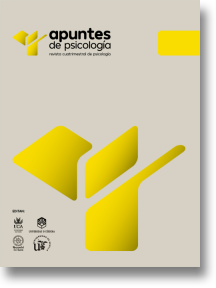The Socioemotional climate in A Lama penitentiary (Pontevedra, Spain)
DOI:
https://doi.org/10.55414/tk14bf60Keywords:
socioemotional climate, educational opportunities, penitentiaryAbstract
This study examines the socioemotional climate in A Lama prison (Pontevedra, Spain). The study involved 153 participants, male (82.9 %), with an average age of 42.33 (SD = 11.40) years. Correlation analyses showed significant relationships between various affective processes, such as hope, solidarity, trust, and hatred, as well as associations between fear and the feeling of loneliness. Mediation analysis confirmed that educational opportunities for inmates
not only increase joy but also reduce anger, contributing to a positive socioemotional climate. These results highlight the complexity of socioemotional experiences in the prison context, emphasizing the importance of simultaneously considering multiple emotional processes to gain a deeper understanding of the penitentiary socioemotional climate.
Downloads
References
Agúndez Del Castillo, R., Maiztegui-Oñate, C. y Navarro-Lashayas, M.A. (2022). La percepción del clima social en instituciones penitenciarias y su relación con el apoyo social: retos y oportunidades. OBETS. Revista de Ciencias Sociales, 17(1), 31-46. https://doi.org/10.14198/OBETS2022.17.1.02
Bagnall, A.M., South, J., Hulme, C., Woodall, J., Vinall-Collier, K., Raine, G., Kinsella, K., Dixey, R., Harris, L. y Wright, N.M. (2015). A systematic review of the effectiveness and costeffectiveness of peer education and peer support in prisons. BMC Public Health, 15(1), 290. https://doi.org/10.1186/s12889-015-1584-x
Baidawi, S., Trotter, C. y Flynn, C. (2016). Prison experiences and psychological distress among older inmates. Journal of Gerontological Social Work, 59, 252-270. https://doi.org/10.1080/01634372.2016.1197353
Beijersbergen, K.A., Dirkzwager, A.J., Eichelsheim, V.I., Van der Laan, P.H. y Nieuwbeerta, P. (2015). Procedural justice, anger, and prisoners’ misconduct: A longitudinal study. Criminal Justice and Behavior, 42(2), 196-218. https://doi.org/10.1177/0093854814550710
Cabrera-Cabrera, P.J. y Ríos-Martín, J.C. (2002). Mirando al abismo: el régimen cerrado. Universidad Politécnica de Comillas.
Chiclana, S., Castillo-Gualda, R., Paniagua, D. y Rodríguez-Carvajal, R. (2019). Salud mental, afectividad positiva y bienestar en prisión: un estudio comparativo entre jóvenes y mayores presos. Revista Española de Sanidad Penitenciaria, 21(3), 147-157. https://dx.doi.org/10.4321/s1575-06202019000300004
Crewe, B., Liebling, A. y Hulley, S. (2011). Staff culture, use of authority and prisoner quality of life in public and private sector prisons. Australian and New Zealand Journal of Criminology, 44(1), 94-11. https://doi.org/10.1177/0004865810392681
Curran, P.G. (2016). Methods for the detection of carelessly invalid responses in survey data. Journal of Experimental Social Psychology, 66, 4-19. https://doi.org/10.1016/j.jesp.2015.07.006
de Rivera, J. (1992). Emotional climate: Social structure and emotional dynamics. International Review of Studies on Emotion, 2, 197-218.
de Rivera, J., y Páez, D. (2007). Emotional climate, human security, and cultures of peace. Journal of Social Issues, 63, 233-253. https://doi.org/10.1111/j.1540-4560.2007.00506.x
de Rivera, J. y Yurtsever, G. (2010). National emotional climate and the value of freedom. Beliefs and Values, 2, 57-65. https://doi.org/10.1891/1942-0617.2.1.57
Dye, M.H. (2010). Deprivation, importation, and prison suicide: Combined effects of institutional conditions and inmate composition. Journal of Criminal Justice, 38, 796-806. http://dx.doi.org/10.1016/j.jcrimjus.2010.05.007
Fernández, I. (2023). Cultura y conducta social. En S. Fernández, I. Fernández, M. Fuster, D. Lois y A. Vázquez (Coords.), Psicología social (vol. II, pp.185-214). Sanz & Torres/UNED.
Gonçalves, L.C., Endrass, J., Rossegger, A. y Dirkzwager, A.J. (2016). A longitudinal study of mental health symptoms in young prisoners: Exploring the influence of personal factors and the correctional climate. BMC Psychiatry, 16, 91-101. http://dx.doi.org/10.1186/s12888-016-0803-z
Goomany, A. y Dickinson, T. (2015). The influence of prison climate on the mental health of adult prisoners: A literature review. Journal of Psychiatric and Mental Health Nursing, 22, 413-422. http://dx.doi.org/10.1111/jpm.12231
Hayes, A.F. (2022). Introduction to mediation, moderation, and conditional process analysis: A regression-based approach (3rd Ed.). The Guilford Press.
Huey, M.P. y McNulty, T.L. (2005). Institutional conditions and prison suicide: Conditional effects of deprivation and overcrowding. The Prison Journal, 85, 490-514. http://dx.doi.org/10.1177/0032885505282258
King, L.A. (2008). Interventions for enhancing subjective wellbeing: Can we make people happier, and should we? En M. Eid y R.J. Larsen (Eds.), The science of subjective well-being (pp. 431-448). Guilford Press.
Kirby, L.D., Tugade, M.N. y Shiota, M.N. (2020). Conclusions and future directions. En M.N. Tugade, M.N. Shiota y L.D. Kirby (Eds.), Handbook of positive emotions (pp. 479-485). The Guilford Press.
Kreager, D.A., Palmen, H., Dirkzwager, A.J. y Nieuwbeerta, P. (2016). Doing your own time: Peer integration, aggression, and mental health in Dutch male detainment facilities. Social Science and Medicine, 151, 92-99. http://dx.doi.org/10.1016/j.socscimed.2016.01.004
Laws, B. (2018). Emotions in prison: an exploration of space, emotion regulation and expression. Universidad de Cambridge. https://doi.org/10.17863/CAM.28033
Liebling, A. y Arnold, H. (2004). Prisons and their moral performance: A study of values, quality, and prison life. Oxford University Press. http://dx.doi.org/10.1093/oso/9780199271221.001.0001
Liebling, A. y Arnold, H. (2012). Social relationships between prisoners in a maximum security prison: Violence, faith, and the declining nature of trust. Journal of Criminal Justice, 40, 413-424. http://dx.doi.org/10.1016/j.jcrimjus.2012.06.003
Liebling, A. y Ludlow, A. (2016). Suicide, distress, and the quality of prison life. En Y. Jewkes, B. Crewe y J. Bennett (Eds.), Handbook on prisons (pp. 224-245). Routledge. http://dx.doi.org/10.4324/9781315797779-14
McCorkle, R.C. (1993). Fear of victimization and symptoms of psychopathology among prison inmates. Journal of Offender Rehabilitation, 19, 27-42. http://dx.doi.org/10.1300/J076v19n01_02
Páez, D., Ruiz, J.I., Gailly, O., Kornblit, A.l., Wiesenfeld, E., y Vidal, C.M. (1996). Clima emocional: su concepto y medición mediante una investigación transcultural. Revista de Psicología Social, 12, 79-98. http://dx.doi.org/10.1174/021347497320892045
Parsons, J.M. (2017). Cooking with offenders to improve health and well-being. British Food Journal, 119, 1079-1090. http://dx.doi.org/10.1108/BFJ-10-2016-0453
Pinheiro, M., Cunha, O. y Gonçalves, R.A. (2020). Emotions, affections, and psychopathy among female prisoners. International Journal of Offender Therapy and Comparative Criminology, 64(6-7), 708-729. https://doi.org/10.1177/0306624X19895976
Pizarro, J. y Stenius, V.M. (2004). Supermax prisons: Their rise, current practices, and effect on inmates. The Prison Journal, 84, 248-264. http://dx.doi.org/10.1177/0032885504265080
Ruiz, J.I. (2007). Emotional climate in organizations: Applications in Latin American prisons. Journal of Social Issues, 63, 289-306. http://dx.doi.org/10.1111/j.1540-4560.2007.00509.x
Ruiz, J.I. (2014). Psicología social y justicia. Universidad Nacional de Colombia - Colegio Colombiano de Psicología.
Secretaría General de Instituciones Penitenciarias (SGIP) (2022). Informe General 2022. Ministerio del Interior. https://www.interior.gob.es/opencms/pdf/archivos-y-documentacion/documentacion-y-publicaciones/publicaciones-descargables/publicaciones-periodicas/informe-general-de-institucionespenitenciarias/Informe_General_IIPP_2022_12615039X.pdf
Sykes, G. (1958). The society of captives. Princeton University Press.
Toch, H. (1977). Living in the prison: The ecology of survival. Free Press.
Van der Helm, P., Beunk, L., Stams, G.J. y Van der Laan, P. (2014). The relationship between detention length, living group climate, coping, and treatment motivation among juvenile delinquents in a youth correctional facility. The Prison Journal, 94, 260-275. http://dx.doi.org/10.1177/0032885514524884
Van der Kaap-Deeder, J., Audenaert, E., Vandevelde, S., Soenens, B., Van Mastrigt, S., Mabbe, E. y Vansteenkiste, M. (2017). Choosing when choices are limited: The role of perceived afforded choice and autonomy in prisoners’ wellbeing. Law and Human Behavior, 41, 567-578. https://doi.org/10.1037/lhb0000259
Vázquez-Cano, E., Holgueras-González, A.I. y Fombona-Cadavieco, J. (2019). Studying for a university degree in penitentiary centers in Spain: Challenges and difficulties from the internee’s perspective. The Prison Journal, 99(5), 593-613. https://doi.org/10.1177/0032885519875074
Woessner, G. y Schwedler, A. (2014). Correctional treatment of sexual and violent offenders: Therapeutic change, prison climate, and recidivism. Criminal Justice and Behavior, 41, 862-879. http://dx.doi.org/10.1177/0093854813520544
Wooldredge, J.D. (1999). Inmate experiences and psychological well-being. Criminal Justice and Behavior, 26(2), 235-250. https://doi.org/10.1177/0093854899026002005
Wright, K.N. (1985). Developing the Prison Environment Inventory. Journal of Research in Crime and Delinquency, 22(3), 257-277. https://doi.org/10.1177/0022427885022003005
Wright, K.N. (1991). A study of individual, environmental, and interactive effects in explaining adjustment to prison. Justice Quarterly, 8(2), 217-242. https://doi.org/10.1080/07418829100091011
Downloads
Published
Issue
Section
License
Copyright (c) 2024 Apuntes de Psicología

This work is licensed under a Creative Commons Attribution-NonCommercial-NoDerivatives 4.0 International License.


















